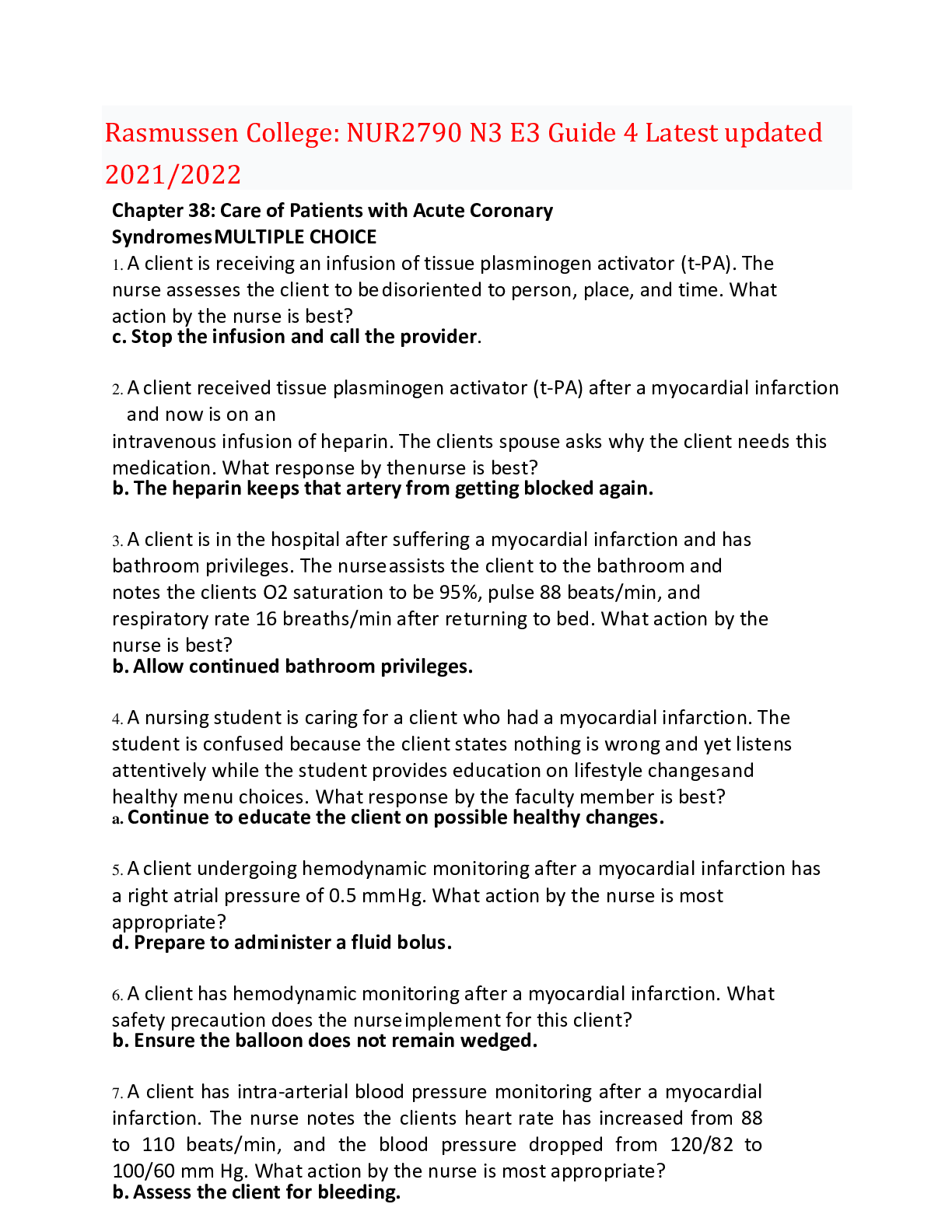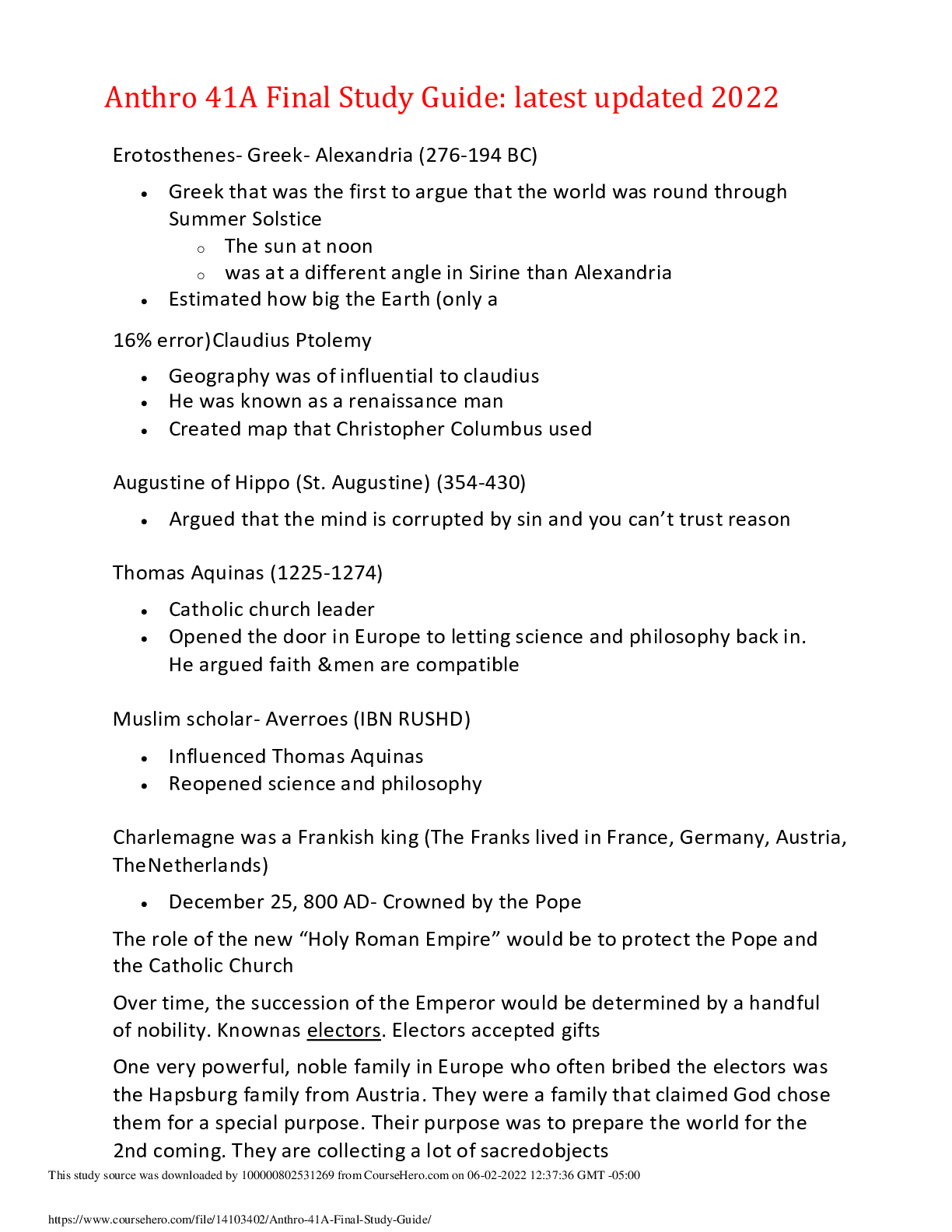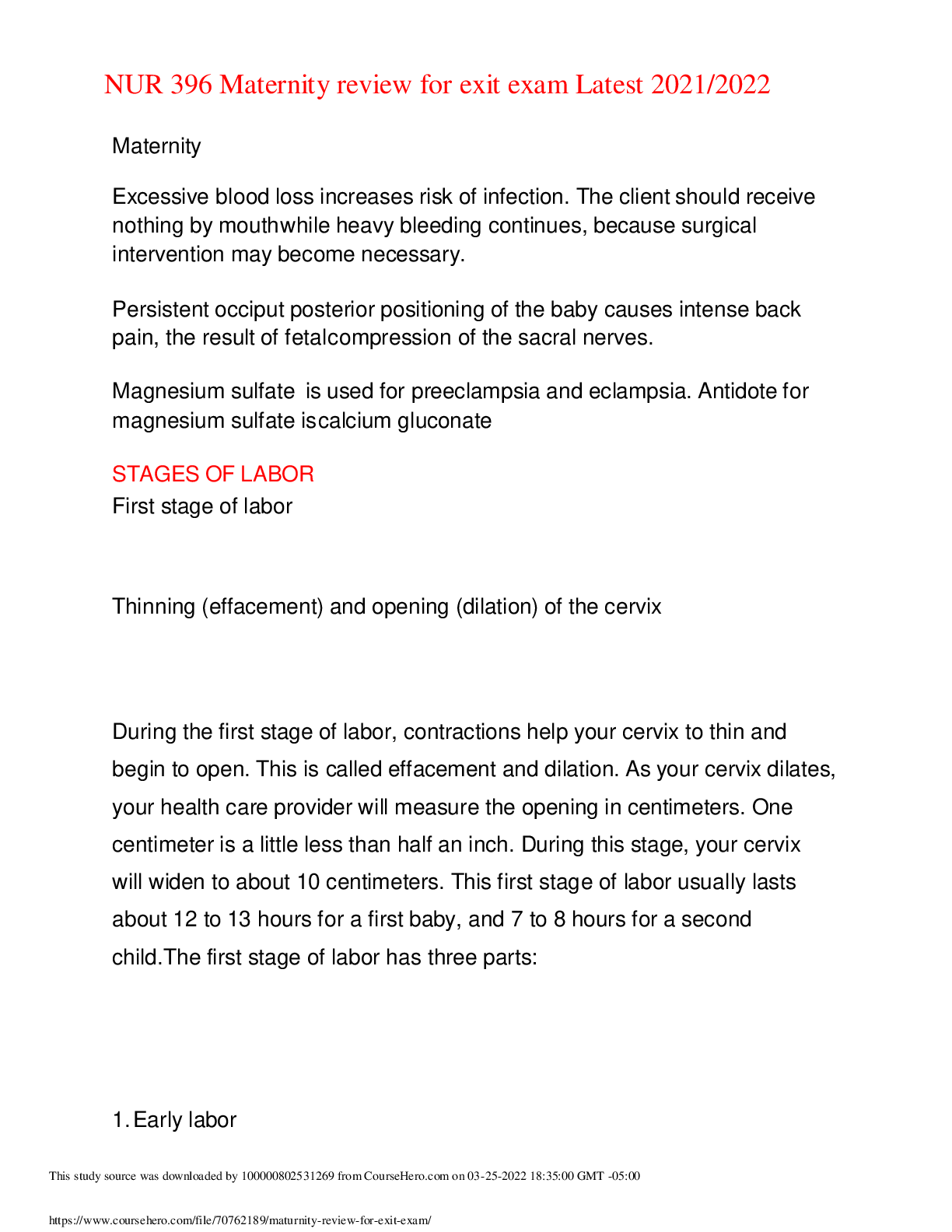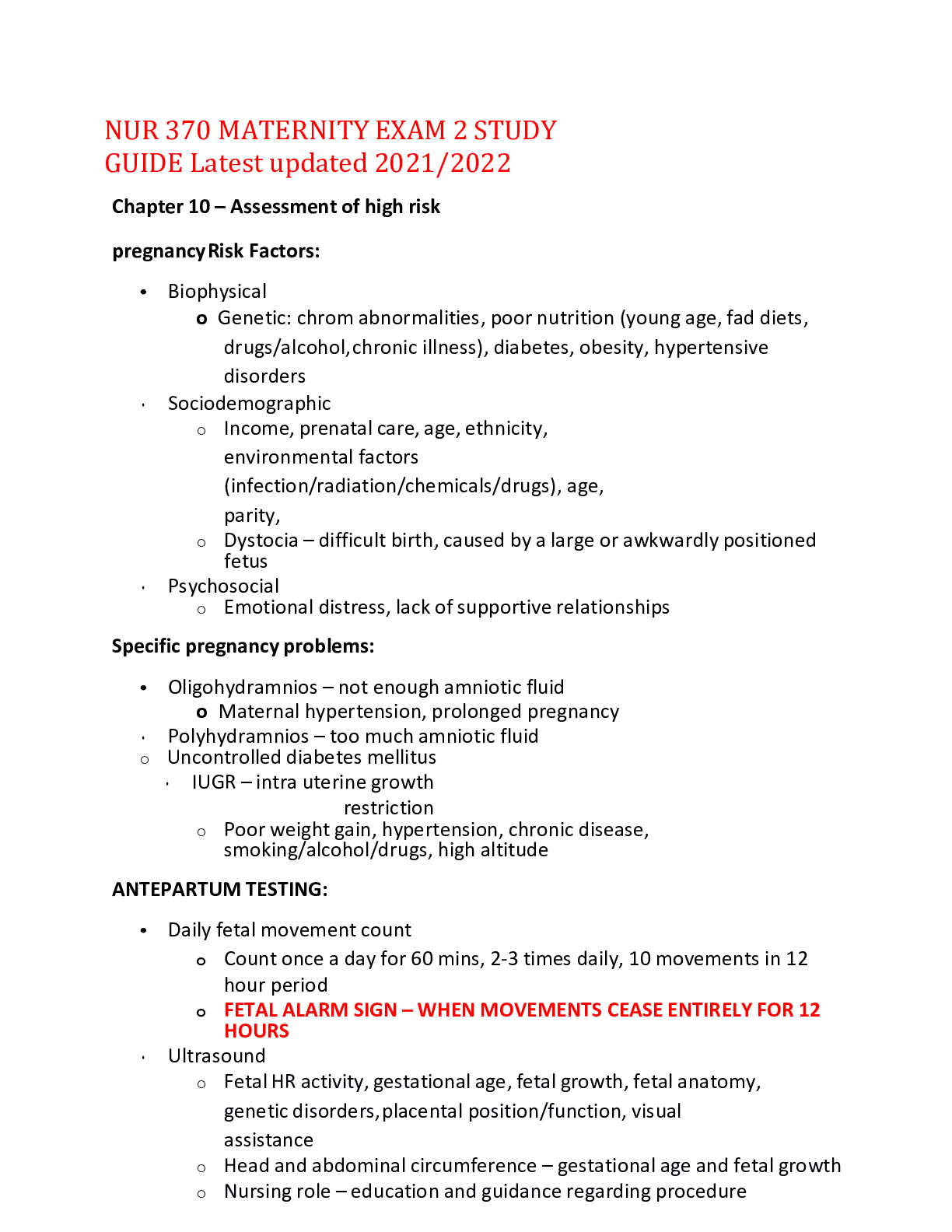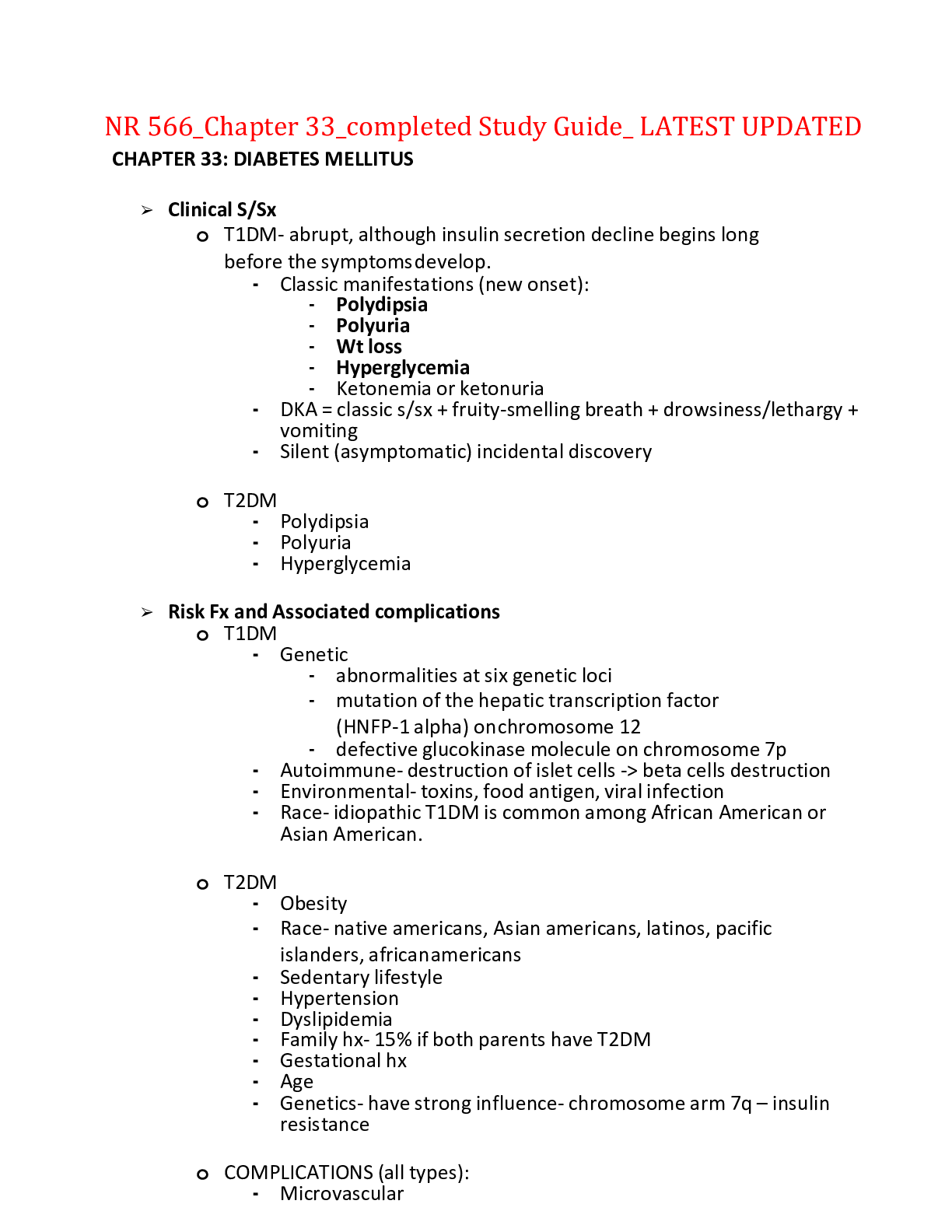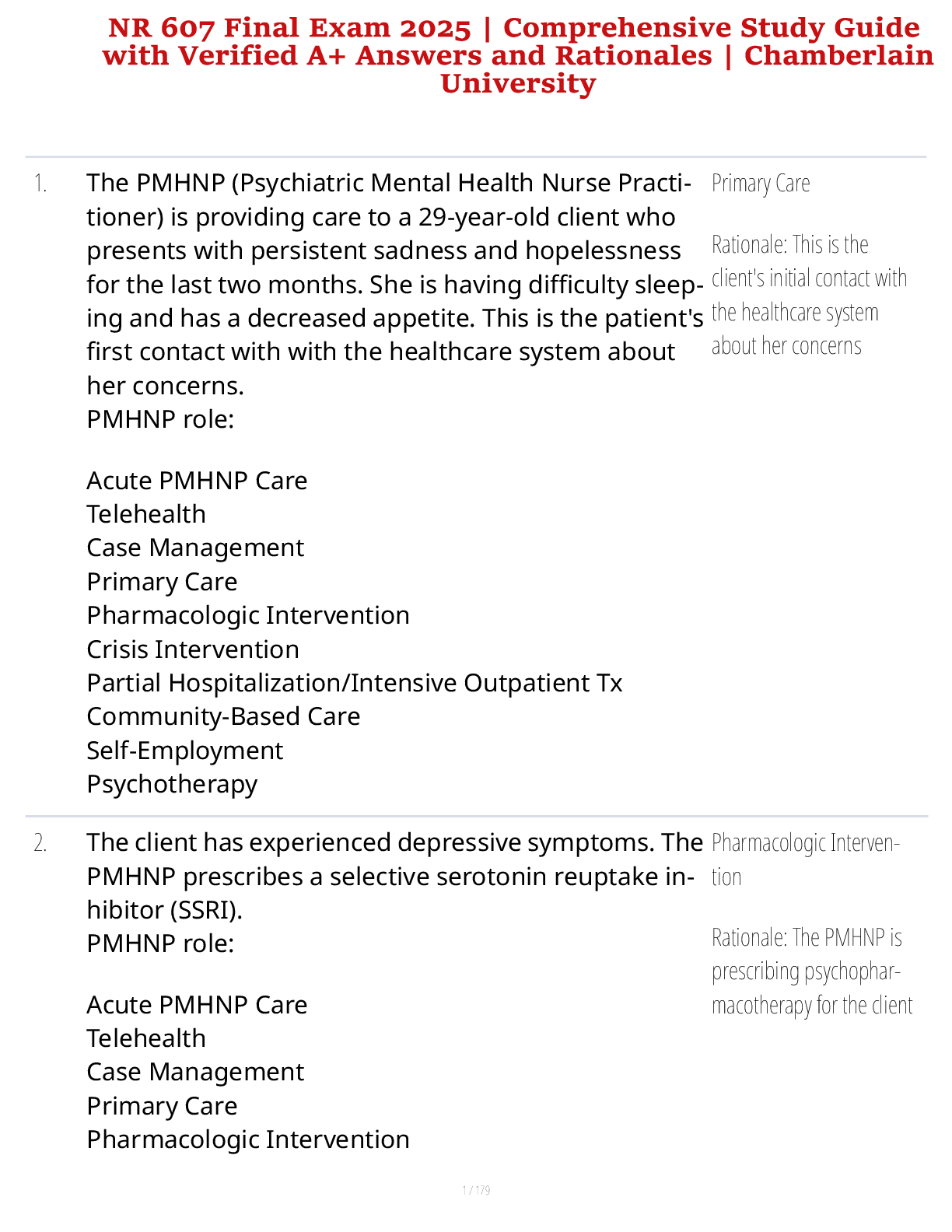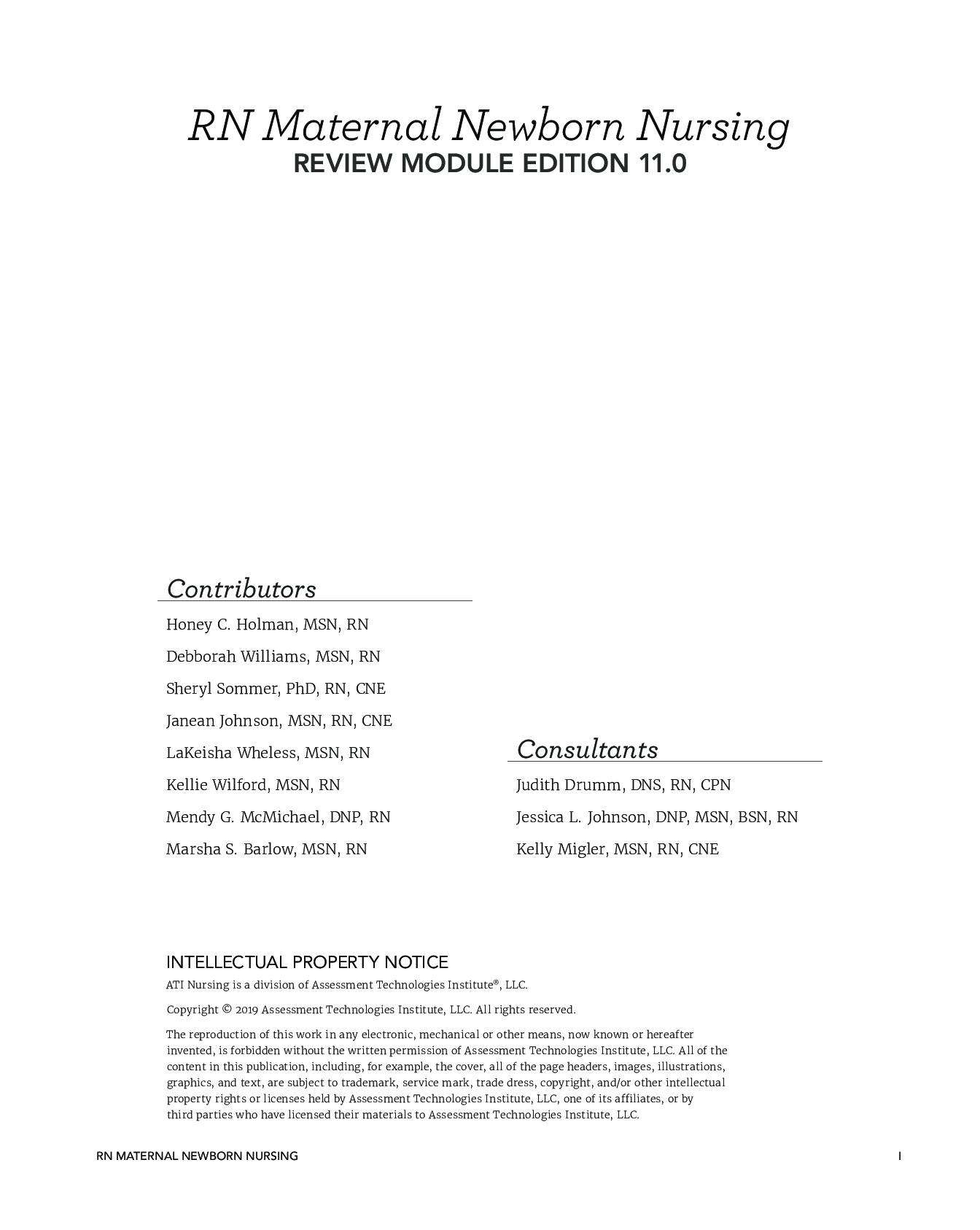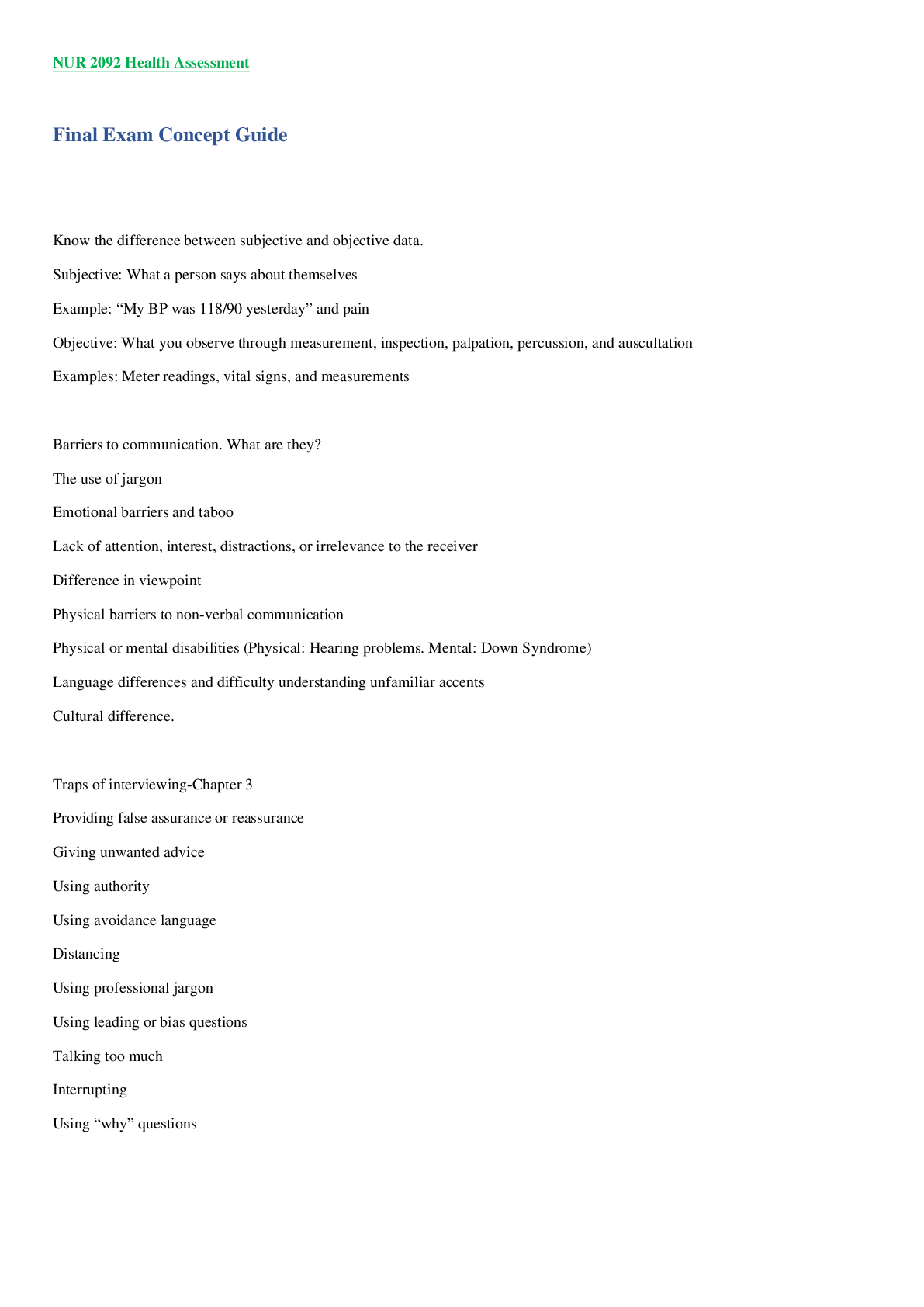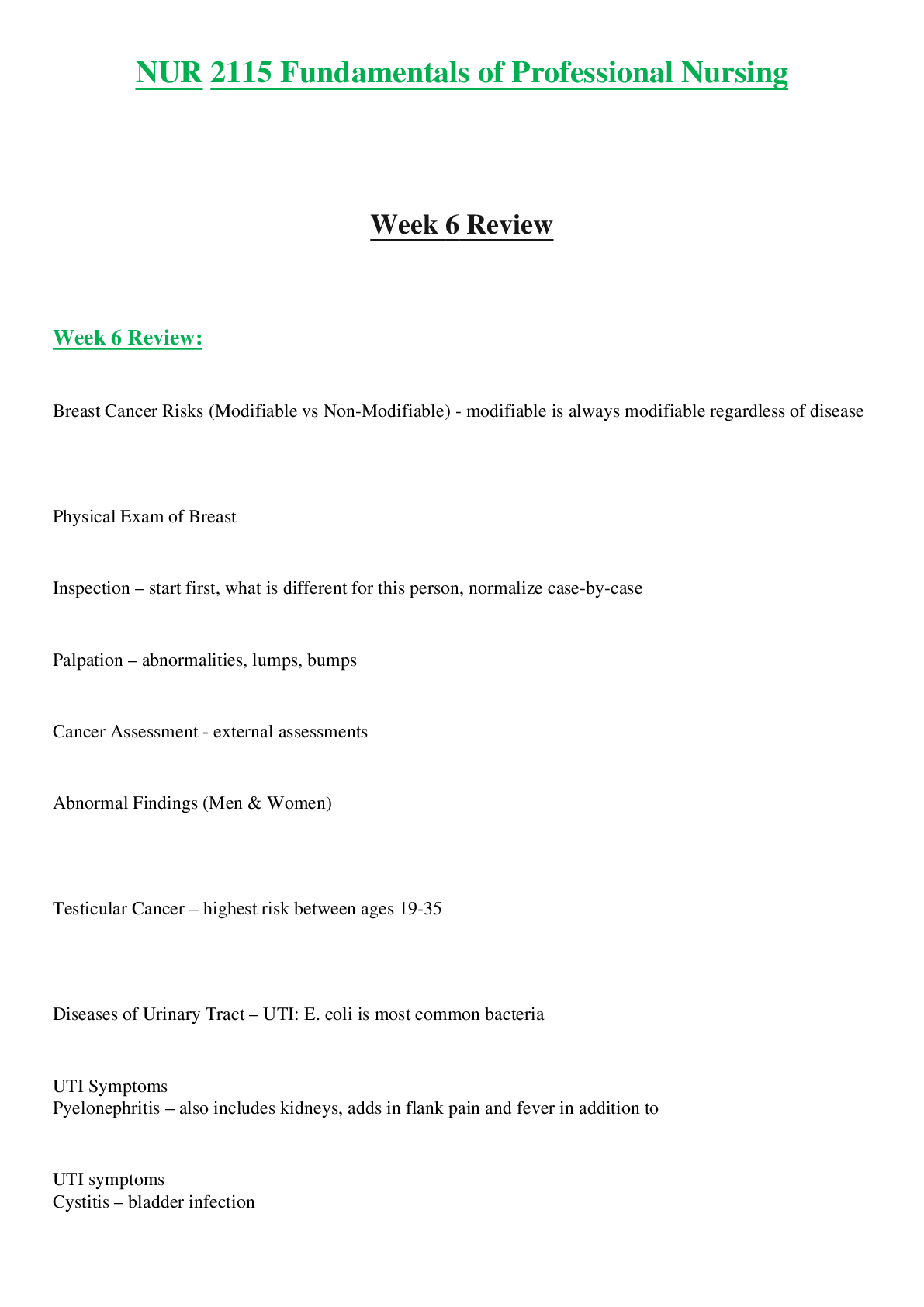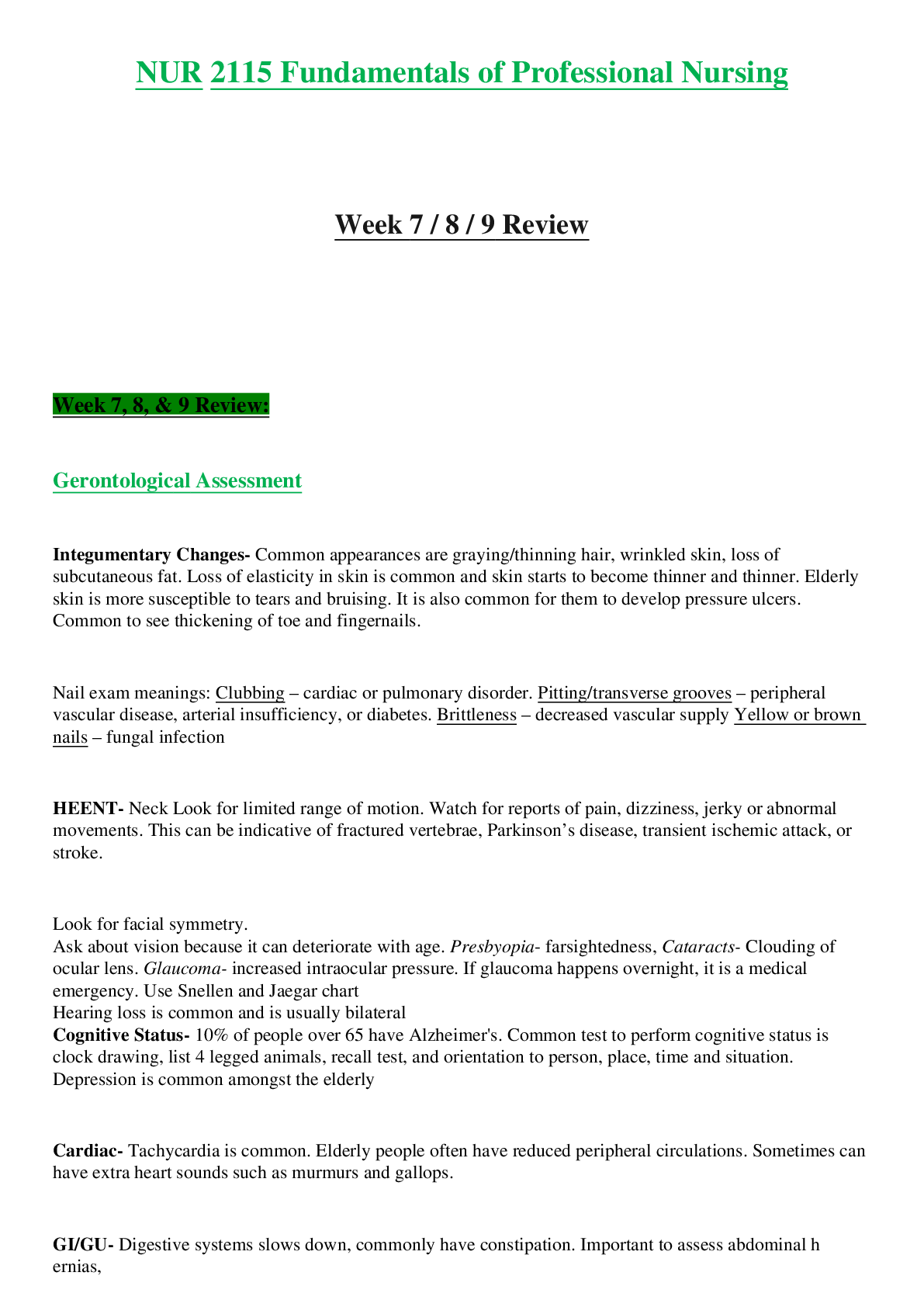*NURSING > STUDY GUIDE > NSG 5003 Week 1 Study Guide ( QUESTIONS & ANSWERS) 100% CORRECT (All)
NSG 5003 Week 1 Study Guide ( QUESTIONS & ANSWERS) 100% CORRECT
Document Content and Description Below
What is the sequence of steps in the development of a digestive enzyme by the pancreas cells from the initial transcription to the release from the cells? a. The enzyme is transcribed form DNA by RNA ... in the nucleus, proceeds to the ribosome for synthesis, and is transported in a secretory vesicle to the cell membrane. b. The enzyme is transcribed from RNA by DNA in the nucleus, proceeds to the lysosome for synthesis, and is transported in an encapsulated membrane to the cell membrane. c. The enzyme is transcribed by the mitochondria int he nucleus, proceeds to the ribosome for synthesis, and is transported in a cytoskeleton to the cell membrane. d. The enzyme is transcribed from DNA by RNA in the nucleus, proceeds to the Golgi complex for synthesis, and is transported in a cytosol in the cell membrane. 2. Which organic compounds facilitate transportation across the cell membrane by acting as receptors, transport channels for electrolytes, and enzymes to drive active pumps? a. Lipids b. Proteases c. Proteins d. Carbohydrates Proteins act as (1) recognition and binding units (receptors) for substances moving in and out of the cell; (2) pores or transport channels for various electrically charged particles called ions or electrolytes and specific carriers for amino acids and monosaccharides; and (3) specific enzymes that drive active pumps that promote the concentration of certain ions, particularly potassium (K+), within the cell while keeping concentrations of other ions, for example, sodium (Na+), below the concentrations found in the extracellular environment. The other options do not correctly describe this process 3. Understanding the various steps of proteolytic cascades, such as caspase-mediated apoptosis and complement cascades, may be useful in designing drug therapy for which human diseases? a. Cardiac and vascular disorders b. Autoimmune and malignant disorders c. Gastrointestinal and renal disorders d. Endocrine and gastrointestinal disorders Understanding the various steps involved in this process is crucial for designing drug interventions. Dysregulation of proteases features prominently in many human diseases, including cancer, autoimmunity, and neurodegenerative disorders. The other options do not correctly describe this process. 4.Which structure prevents water-soluble molecules from entering cells across the plasma membrane? a. Carbohydrate chains b. Glycoprotein channels c. Membrane channel proteins d. Lipid bilayer The bilayer's structure accounts for one of the essential functions of the plasma membrane. It is impermeable to most water-soluble molecules (molecules that dissolve in water) because the water-soluble molecules are insoluble in the oily core region. The bilayer serves as a barrier to the diffusion of water and hydrophilic substances while allowing lipid-soluble molecules, such as oxygen (O2) and carbon dioxide (CO2), to diffuse through it readily. The other options do not correctly describe this process. 5. Which form of cell communication is used to communicate within the cell itself and with other cells in direct physical contact? a. Protein channel (gap junction) b. Plasma membrane-bound signaling molecules (involving receptors) c. Hormone secretion such as neurotransmitters d. Extracellular chemical messengers such as ligands Cells communicate by using hundreds of kinds of signal molecules, for example, insulin. Cells communicate in three main ways; they display plasma membrane-bound signaling molecules (receptors) that affect the cell itself and other cells in direct physical contact. The other options do not correctly describe this process. 6. Which mode of chemical signaling uses blood to transport communication to cells some distance away? a. Paracrine b. Autocrine c. Neurotransmitter d. Hormonal Chemical signaling can be classified into three categories: (1) local-chemical mediator, (2) hormone, and (3) neurotransmitter. In the local-chemical mediator model, the secreted chemical acts on the cells in the immediate environment. Hormones are used for communication with distant target cells. For example, cells can secrete a chemical and rely on the blood system to deliver the signal to a distant cell. Finally, neurotransmitters are secreted by neurons to stimulate an adjoining cell. For example, a neuron might secrete acetylcholine to stimulate the movement of a muscle cell 7. Which mode of chemical signaling uses local chemical mediators that are quickly taken up, destroyed, or immobilized? a. Paracrine b. Autocrine c. Neurotransmitter d. Hormone In paracrine signaling, cells secrete local chemical mediators that are quickly taken up, destroyed, or immobilized. The other options do not correctly describe this process 8.How do cells receive communication from the ECF surrounding them? a. Protein channel (gap junction) b. Plasma membrane-bound signaling molecules (involving receptors) c. Hormone secretion such as neurotransmitters d. Chemical messengers such as ligands Cellular communication can occur by the binding of a chemical massager (a ligand) to a specific membrane receptor that is closely associated with the channel (e.g., G proteins). The other options do not correctly describe how cells communicate. 9. Under anaerobic conditions, which process provides energy for the cell? a. Oxidative phosphorylation b. Glycolysis c. Lactolysis d. Passive transport Glycolysis produces a net of two molecules of ATP per glucose molecule through the process of oxidation or the removal and transfer of a pair of electrons. The other options do not correctly identify an anaerobic process that provides energy to the cell. 10. What is the mechanism by which the energy produced from carbohydrates, proteins, and lipids is transferred to ATP? a. Anaerobic glycolysis b. Oxidative cellular metabolism c. Oxidative phosphorylation d. Tricarboxylic acid phosphorylation Oxidative phosphorylation occurs in the mitochondria and is the mechanism by which the energy produced from carbohydrates, fats, and proteins is transferred to ATP. The other options do not correctly identify the mechanism described in the question 11. Passive transport is best described by which statement? a. Being driven by osmosis, hydrostatic pressure, and diffusion b. Involving receptors that can bind with substances being transported c. Being capable of transporting macromoleclues d. Requiring energy generated by the cell Water and small electrically uncharged molecules move easily through pores in the plasma membrane's lipid bilayer. This process, called passive transport, naturally occurs through any semipermeable barrier. It is driven by osmosis, hydrostatic pressure, and diffusion, all of which depend on the laws of physics and do not require life. The other options do not correctly describe passive transport 12. Active transport occurs across which type of membranes? a. Membranes that have a higher concentration of the solute on the outside of the cell. b. Membranes that are semipermeable to water and small electrically uncharged molecules c. Membranes that have receptors that are capable of binding with the substances to be transported d. Membranes that have a cell membrane that is hydrophobic rather than hydrophilic Some molecules are moved into the cell by mechanisms of active transport, which require receptors that are capable of recognizing and binding with the substance to be transported. Diffusion is the movement of a solute molecule from an area of greater solute concentration to an area of lesser solute concentration. Hydrostatic pressure is the mechanical force of water pushing against cellular membranes. Osmosis is the movement of water down a concentration gradient; that is, across a semipermeable membrane from a region of higher water concentration to a lower water concentration 13. Why is osmolality preferred over osmolarity as the measurement of osmotic activity in the clinical assessment of individuals? a. Plasma contains sodium and chloride, which influences the volume of solution. b. Volume affects perfusion more than the weight of solutes. c. More of the weight of plasma is influence by solutes, such as protein and glucose, rather than by water. d. Osmotic activity depends on the concentration of solutes present in plasma, such as proteins and glucose. In plasma, less of the plasma weight is water; therefore the overall concentration of particles is greater. The osmolality will be greater than the osmolarity because of the smaller proportion of water. Osmolality is thus the preferred measure of osmotic activity in clinical assessment of individuals 14. Why is it possible for potassium to diffuse easily into and out of cells? a. Potassium has a greater concentration in the intracellular fluid (ICF). b. Sodium has a greater concentration in the extracellular fluid (ECF). c. The resting plasma membrane is more permeable to potassium. d. An excess of anions are inside the cell. Because the resting plasma membrane is more permeable to K+ than to Na+, K+ can easily diffuse from its area of higher concentration in the ICF to its area of lower concentration in the ECF. Because Na+ and K+ are both cations, the net result is an excess of anions inside the cell, resulting in the resting membrane potential. The remaining options do not correctly identify the process that most easily diffuses K+. 15. What causes a rapid change in the resting membrane potential to initiate an action potential? a. Potassium gates open, and potassium rushes into the cell, changing the membrane potential from negative to positive. b. Sodium gates open, and sodium rushes into the cell, changing the membrane potential from negative to positive. c. Sodium gates close, allowing potassium into the cell to change the membrane potential from positive to negative. d. Potassium gates close, allowing sodium into the cell to change the membrane potential from positive to negative. When a resting cell is stimulated through voltage-regulated channels, the cell membranes become more permeable to Na+. A net Na+ moves into the cell, and the membrane potential decreases, or moves forward, from a negative value (in millivolts) to zero. The Na+ gates open, and Na+ rushes into the cell, causing the membrane potential to reduce to zero and then become positive (depolarization). The remaining options do not correctly describe the change that initiates an action potential. 16. The action of the platelet-derived growth factor is to stimulate the production of which cells? a. Platelets b. Epidermal cells c. Connective tissue cells d. Fibroblast cells Different types of cells require different factors; for example, platelet-derived growth factor stimulates the production of connective tissue cells. The remaining options do not correctly describe the action of platelet-derived growth factor 17. What is a consequence of leakage of lysosomal enzymes during chemical injury? a. Enzymatic digestion of the nucleus and nucleolus occurs, halting DNA synthesis. b. Influx of potassium ions into the mitochondria occurs, halting the ATP production. c. Edema of the Golgi body occurs, preventing the transport of proteins out of the cell. d. Shift of calcium out of the plasma membrane occurs, destroying the cytoskeleton. Enzymatic digestion of cellular organelles, including the nucleus and nucleolus, ensues, halting the synthesis of DNA and ribonucleic acid (RNA). The remaining options do not accurately describe the consequence of lysosomal enzyme leakage during chemical injury. 18. During cell injury caused by hypoxia, an increase in the osmotic pressure occurs within the cell because: a. Plasma proteins enter the cell. b. The adenosine triphosphatase (ATPase)-driven pump is stronger during hypoxia. c. Sodium chloride enters the cell. d. An influx of glucose occurs through the injured cell membranes. In hypoxic injury, movement of fluid and ions into the cell is associated with acute failure of metabolism and a loss of ATP production. Normally, the pump that transports sodium ions out of the cell is maintained by the presence of ATP and ATPase, the active-transport enzyme. In metabolic failure caused by hypoxia, reduced ATP and ATPase levels permit sodium to accumulate in the cell, whereas potassium diffuses outward. The increase of intracellular sodium increases osmotic pressure, which draws more water into the cell. (Transport mechanisms are described in Chapter 1.) The remaining options do not accurately describe the cell injury that results in increased osmotic pressure caused by hypoxia. 19. Which statement is true regarding the difference between a subdural hematoma and an epidural hematoma? a. No difference exists, and these terms may be correctly used interchangeably. b. A subdural hematoma occurs above the dura, whereas an epidural hematoma occurs under the dura. c. A subdural hematoma is often the result of shaken baby syndrome, whereas an epidural hematoma rapidly forms as a result of a skull fracture. d. A subdural hematoma usually forms from bleeding within the skull, such as an aneurysm eruption, whereas an epidural hematoma occurs from trauma outside the skull, such as a blunt force trauma. A subdural hematoma is a collection of blood between the inner surface of the dura mater and the surface of the brain, resulting from the shearing of small veins that bridge the subdural space. Subdural hematomas can be the result of blows, falls, or sudden acceleration-deceleration of the head, which occurs in the shaken baby syndrome. An epidural hematoma is a collection of blood between the inner surface of the skull and the dura and is almost always associated with a skull fracture. The other options do not accurately describe the differences between the two hematomas. 20. During cell injury caused by hypoxia, sodium and water move into the cell because: a. Potassium moves out of the cell, and potassium and sodium are inversely related. b. The pump that transports sodium out of the cell cannot function because of a decrease in ATP levels. c. The osmotic pressure is increased, which pulls additional sodium across the cell membrane. d. Oxygen is not available to bind with sodium to maintain it outside of the cell. A reduction in ATP levels causes the plasma membrane's sodium-potassium (Na+-K+) pump and sodium-calcium exchange to fail, which leads to an intracellular accumulation of sodium and calcium and diffusion of potassium out of the cell. (The Na+-K+ pump is discussed in Chapter 1.) [Show More]
Last updated: 3 years ago
Preview 1 out of 4 pages
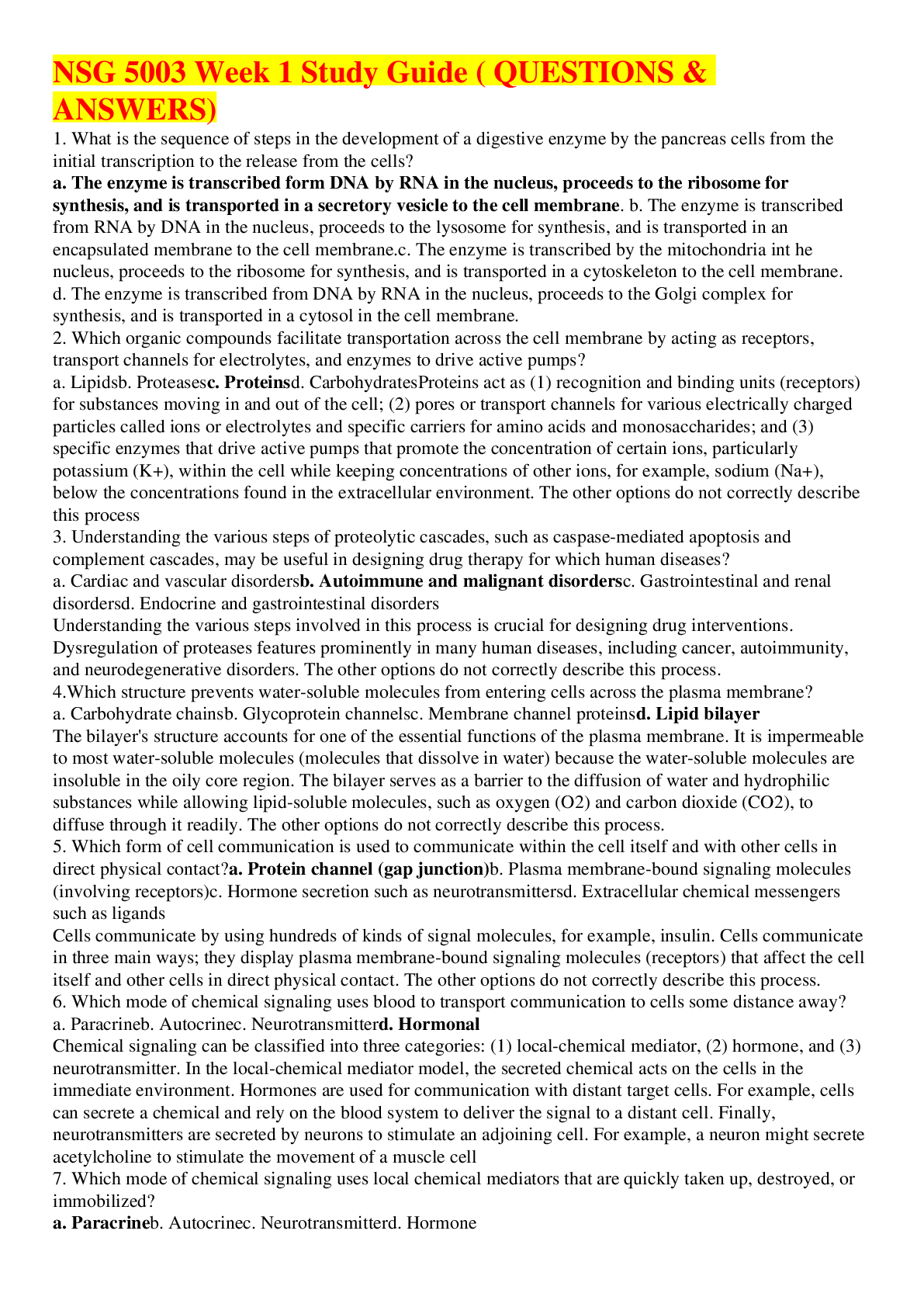
Buy this document to get the full access instantly
Instant Download Access after purchase
Buy NowInstant download
We Accept:

Reviews( 0 )
$15.00
Can't find what you want? Try our AI powered Search
Document information
Connected school, study & course
About the document
Uploaded On
Oct 26, 2020
Number of pages
4
Written in
All
Additional information
This document has been written for:
Uploaded
Oct 26, 2020
Downloads
0
Views
117

.png)



